MacKay single-double gaps
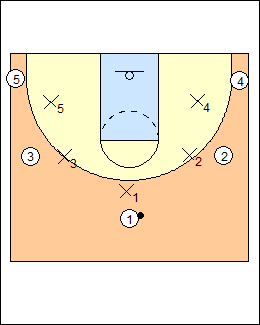 | 1 Mike MacKay YouTube video - Single and Double Gaps (and How to Teach Cutting). Use backcuts and blast cuts to create double gaps for dribble penetration (see Progressions for basket cuts). Spacing creates gaps, cutting creates bigger gaps. See Offence - 5-out creating gaps, Blog Posts - 5-Out Dribble Penetration, Blast Cuts, Conceptual Offence. 5-out offence is used by many youth teams. The problem is that the spacing is single gaps. When there is a stationary pass, the defender is closer to the ball than the pass receiver, which often allows a steal. A second issue is that on dribble penetration into a single gap, a defender can quickly help and recover to their check. |
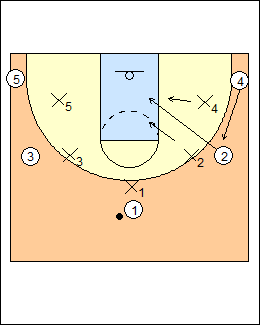 | 2 One advantage of 5-out spacing is a backdoor pass. If help arrives to take away a pass at the rim, the other option is a pass to a perimeter player (here 4). Adam Spinella - Hoiberg 5-Out Concepts - 5-out spacing allows for backcuts, the rim is vacated. Gregg Popovich - if denied anywhere on the court, go backdoor and continue in the direction you were going. Chris Krauss - Motion Concepts - he doesn't like cuts all the way through, cut to the middle, read what's going on, you might have to come back, or relocate. A backcut (or basket cut) to the rim is a scoring opportunity, then exit cut but first read what's going on (e.g. react to a drive or shot). Hal Wissel - keep the middle open, when you cut to the basket, don't stay in the post area for more than a one-count, fill an open spot on the side of the floor with the fewest players. |
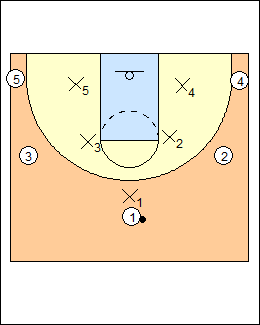 | 3 A lot of teams play sag defence against this type of offence, no backdoors are available. Gap Theory (Spacing) - 5-out spacing (50) stretches the defence outside the paint and takes away a traditional rim protector. |
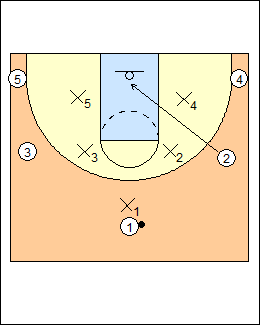 | 4 How can we give the offence an advantage? We like to create a double gap by cutting a player. MacKay - How to Teach Cutting - in a single gap, backcut immediately if you are looked at, dribbled at, or pivoted at. Alex Sarama -Teaching Offensive Concepts - if you are in a single gap, create a double gap for a teammate so they can blast cut. Blast cuts are made from a double gap into a single gap, and give you a speed advantage. Dribble-drive motion - pass through a single gap to open the gap, usually change sides of the floor with a corner cut (cut away on a pass down, cut under on a pass across, hold on a pass up). Attack double and triple gaps. Backcuts and blast cuts are secondary options in DDM. Optionally a) in a single gap, backcut if overplayed or on a pass fake or dribble-at, or if denied on a dribble-at; b) in a double gap, blast cut if there is no drive. See Offence - Dribble-drive outline. |
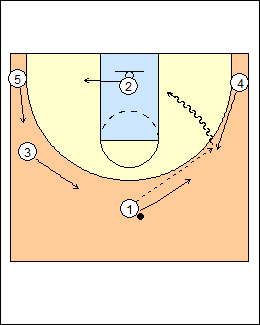 | 5 Options Use a double gap for a blast cut or dribble penetration. a) 4 blast cuts into the double gap for a pass, putting the defence in motion. 4 has a chance to play dynamic 1-on-1, reading the defence before catching the ball and attacking immediately on the catch, here baseline. 2 exits the paint weakside. 1 holds after passing (does not basket cut). See panels 16 to 18. MacKay - How to Teach Cutting - back cut and blast cut to fill behind (it's hard for X4 to help on the backcut by 2 and contest the blast cut by 4). 1 is in a single gap after passing, and backcuts immediately if looked at, dribbled at, or pivoted at, then 3 blast cuts. See Tactics - 3-spot pass-cut-fill, Offences - 5-out youth motion, Huggins open post. ** The blast cut creates baseline space for an immediate drive, or 4 can attack middle using speed. 1 does not need to create a double gap with a basket cut. If 4 delays a blast cut (see below), 2 may need to exit the paint before 4 drives. If 4 doesn't make a play, 1 can backcut and 3 blast cut (see below), the complete sequence is pass-hold-cut-fill. If 1 basket cuts, break it off on a quick drive by 4, otherwise create a double gap for a middle drive by 4, or 3 holds then blast cuts for another dynamic attack. The sequence is pass-cut-hold-fill. Sarama - 4 can backdoor cut, catch and shoot, attack baseline (dynamic cross), or attack middle (curl). How to Teach Youth Motion - automatic drives are a) draft drives (follow a cutter), b) real-estate drives (the spot next to you is empty), c) your defender steps over the 3-point line. Randy Sherman - Improve Conceptual Offence - a) drive opposite a catch (away from where you caught it, not back into the teeth of the defence), b) attack the larger space, Mike MacKay - Read and React Offence - if you are in the key when the ball is being driven to the basket and the ball enters the lane below you, go to the elbows. Or 2 could back-pedal to the short corner, 5 fills the weakside 45-degree angle, 3 fills the 90-degree angle above the ballside elbow, and 1 is the safety moving in behind. Score with 45 Cuts - a baseline drive opens up a weakside 45 cut as defenders help and drop (cover down). Wheel movement - 2 can back out to the corner and 3 make a 45 cut from the wing. See Coach Mac - Read and React Offense. |
 | 6 b) 1 can drive the double gap, breaks the foul line, 4 clears behind (away from X4), gets a pass, 1 exits to the corner. See panels 11-15. (Option) - 3 holds on the far wing, can then react to dribble penetration (see above) or blast cut out top. ** To maintain the double gap for a draft drive, 4 would hold in the corner (for a two-count) before a blast cut. Delay replacing a cutter unless the ballhandler has already had a chance to attack a double gap. Basketball NSW - a cut that is made toward the basket creates space behind for a second cutter, or for the ballhandler to "drive on the back of the cutter". See Offences - 5-out dribble-attack continuity, Kansas weave, 5-out dribble-drive motion, also Dribble-drive outline. |
 | 7 4 has a double gap middle and a long closeout by X4. |
 | 8 Don't freeze the ball and let the help defence set up. Keep the offence moving, the first option is to keep cutting, 3 cuts (a static backcut from a double gap), 5 can go dynamic 1-on-1 into a double gap. 4 does not cut after passing (see above). ** 5 does not delay the blast cut, 4 already had a chance to attack a double gap. The cut by 5 creates another double gap, and 2 delays a fill behind to keep the gap. Read and React - fill open spots above you. Do not be too quick to fill this space as it takes away the penetration of the player with the ball. |
 | 9 5 attacks (a quick real-estate drive) and passes if he doesn't have anything. 3 exits opposite the drive. ** Another option is a blast cut by 2 into the double gap (a blast cut can set up another blast cut), or a backcut by 4 and a blast cut by 1. Read and React - if you are in the key when the ball is being driven to the basket and the ball enters the lane above you, go to the short corner. Coach Daniel - Future of Offence - 4 guys out and one guy in the dunker spot is still 5-out spacing to him. |
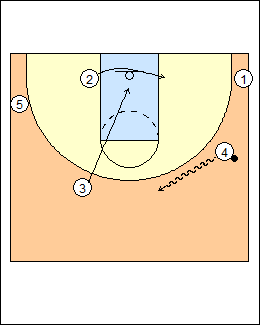 | 10 Re-set - 4 can "dribble centre", it's like a pass, moving the ball with the dribble. 3 makes a backcut when dribbled at (backcut when one gap away). There is a double gap on each side when 4 picks up the ball (1 does not follow behind). ** Doug Novak - Offensive Philosophy - nothing can stop the ball from moving. If you can't swing the ball, dribble at the next offensive player for a backdoor or throw behind [a pitch or DHO]. If you can't throw behind, look to snapback where you dribbled from. Hal Wissel - balance the floor by dribbling to the point.  |
 | (Progressions) 1) See panels 6 to 10. 3 and 5 hold their spots as 1 drives to create a double gap, 3 can then react to dribble penetration or blast cut. |
 | 12 a) Options on a middle drive - 2 relocates, then fills the corner if 3 backcuts, 1 replaces 4 - 3 backcuts to the dunker spot, or rotates behind the drive to get a pitch from 4, or a DHO if 4 gets veered out, or keeps going - 4 makes a DHO to 5 (shown), or stops in the drop zone for a kickup, corner kickout, or backcut by 5 - 3 pins down for 5 into zoom action. On a middle drive there is no blast cut option on the other side. See Offences - Kansas weave, 5-out dribble-attack continuity, Raptors 5-out, Fast breaks - Early 5-out actions (Zoom), Tactics - Wheel movement. |
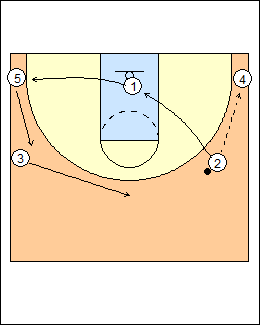 | 13 b) 3 blast cuts if 4 does not attack, creating a double gap to attack or for a blast cut by 5, 4 does not need to basket cut on a dynamic pass. How to Teach Cutting - 3 blast cuts when there is a connection (4 makes eyes contact), shortens the pass, 4 can make a single-gap pass. McNeill - 3 and the ball should arrive at the same time. 3 can backcut, catch and shoot, immediately attack left or right, or square up in triple threat. The blast cut creates a double gap behind 3 for a "real-estate" drive, 5 is ready to blast cut from the corner. If there is no play, 4 can backcut, 1 blast cuts immediately. Another option is a downscreen for 1. Matt Hackenberg - 5-out screen away motion - if denied, backcut or downscreen and fill from behind. A downscreen becomes a staggered screen on a pass to the other side. See Shooting - 3-line drive and kick. |
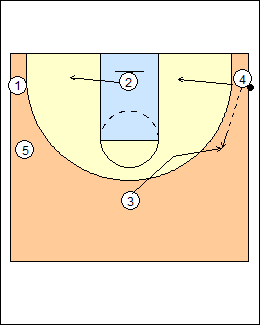 | 14 c) Optionally 5 and 2 fill behind on a blast cut by 3, 5 will backcut from the wing and 2 will play from the corner, See Offence - 5-out dribble-attack continuity. |
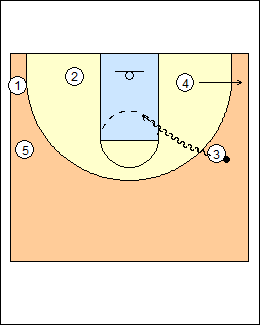 | 15 d) 3 blast cuts then backcuts if overplayed, a dynamic backcut, creating a triple gap. 5 does not delay a blast cut to fill the top, 4 had a double gap to attack, don't stall the ball. Does a teammate need help or space? MacKay - in a triple gap, shorten a pass to a single gap off the dribble and with a blast cut. NSW open-post motion - cutting on the back of a cutter is effective. See Offence - Petitgoue open-post (Revolve). |
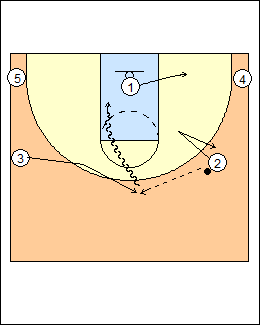 | 16 2) See panel 5. a) 2 backcuts, 4 blast cuts for a pass, 1 holds. |
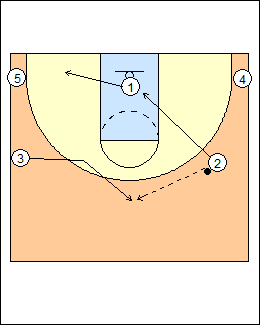 | 17 4 attacks middle, 1 fills (rotates) behind the drive, 3 and 5 have options outlined above. |
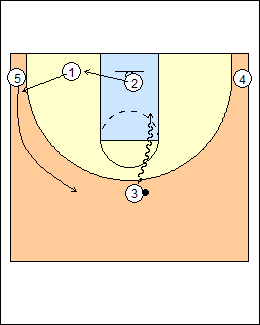 | 18 b) 1 backcuts if 4 does not attack, 2 fills the corner, 3 blast cuts for a pass, setting up a double gap with 5. See above for a dribble centre. |
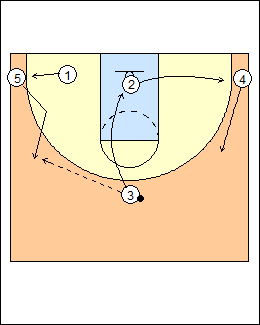 | 19 3) a) Basket cut The offence creates dynamic passes off dribble penetration and blast cuts. If there is a stationary downhill pass (e.g. to a corner or wing), a basket cut unlocks the floor, creating a double gap for a delayed drive behind the cutter (a draft drive) or a blast cut to the ball for a zero-second dynamic attack, especially a "real- estate" drive into a double gap created by the blast cut. A blast cut can lead to another blast cut. A draft drive is a static 1-on-1 but into a double gap. Teaching Offensive Concepts - a double/triple gap, match-up advantage, or late clock is a green-light situation in a static 1-on-1. Instead of a backcut by 2, 1 makes a stationary pass and basket cuts, 2 can drive behind the cutter or 3 blast cuts on eye contact or after a two-count (a delayed fill cut). Progression - optionally basket cut on a downhill dynamic pass. How to Teach Cutting - double-gap spacing gives 2 space to penetrate, but also 3 space to make a blast cut, which is a cut straight to the ball (beat your defender with a speed cut). Alex Sarama - Avoid Pass and Cut Offence - off-ball cutting (ghost cut) makes no sense with pass and cut, and 2 has to wait for the cutter to clear out instead of being able to drive immediately. The idea of modern basketball is to use zero-second decisions. With pass and cut, players are taught to robotically repeat a pattern, not how to play the game. It would be better for players to pass and space, find a window outside the 3-point line. Dribble-drive motion - pass through a single gap to open the gap, usually change sides of the floor with a corner cut (cut away on a pass down, cut, hold on a pass up). Attack double and triple gaps. Randy Sherman - on a diagonal pass (slot to wing), make a diagonal cut directly to the opposite corner. Variation - cut to the weakside dunker spot, so the corner and wing players can hold their spots. See Tactics - 3-spot pass-cut-fill, Offence - 5-out youth motion. |
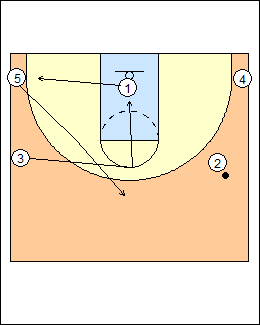 | 20 b) Fan cut 1 passes to 2 and cuts to the opposite wing, pushing 3 down to the corner and 5 through to the dunker spot. This is "early" wheel movement, before 2 actually drives. 2 can make a zero-second attack without waiting for the cutter, or dribble centre the ball if there is no attack. Wheel movement - 3 can slide to the corner then backcut. See Offences - Novak dribble-drive, Tactics - Wheel movement, also Reid Ouse 4-on-4 Cut the Corner (YouTube).  |
This page was made with Basketball playbook from Jes-Soft